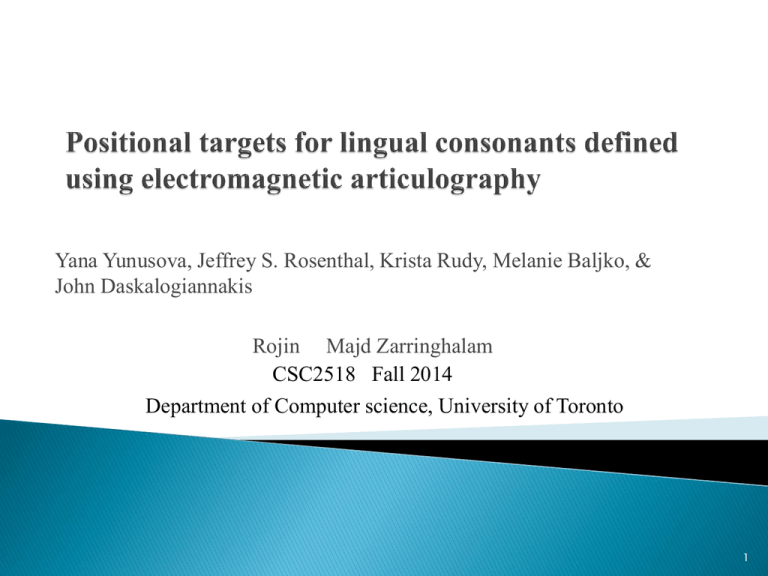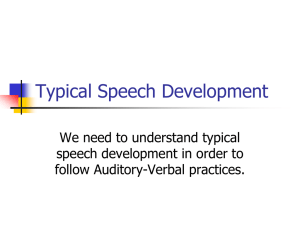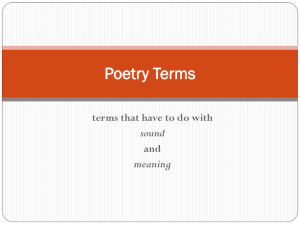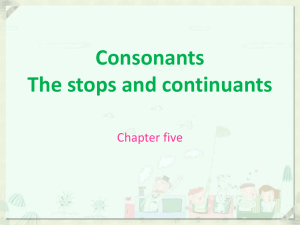
Yana Yunusova, Jeffrey S. Rosenthal, Krista Rudy, Melanie Baljko, &
John Daskalogiannakis
Rojin Majd Zarringhalam
CSC2518 Fall 2014
Department of Computer science, University of Toronto
1
Examine tongue positions during lingual consonants defined using a point
parameterized approach with wave
Identifying which consonants have unique locations in the vocal tract
2
Articulation
Manner of articulation
The movement of the tongue, lips, jaw, and other speech organs to
make speech sounds
How speech organs involved in making a sound make contact
Place of articulation
Positions of speech organs to create distinctive speech sounds
It is an essential parameter in the description of the patterns of
control movement for consonants
3
English Lingual consonant
From front to back are divided to:
Alveolar /d, t, s, z/
Postalveolars / ʃ, ʧ /
Share their place of articulation ,
differences in the manner of production
Differ by voicing
Velar
4
Cognates ( i.e., pairs /d-t/,/s-z/,and /k-g/)
Share the place and manner of articulation
Differ by voicing
5
Different patterning of lingua-palatal contact for stops and fricative
(Dart,1998)
The pattern have been qualified with electropalatography (EGB)
The similarities of tongue contact patterns producing the same
consonants and cognates
The differences in tongue-palate contact between consonant
classes
6
The positional targets have been defined in two-or three- dimensional
space (Guenther, 1995; Keating, 1990; Parkel and Klatt, 1986 )
The directions into velocity of articulation model (Guenther 1995;
Guenther et al., 2006)
Variability of the tongue positions has been influenced by contextual and
speaker related factors (Brunner et al., 2009; Dembowski et al., 1998)
Extent of the tongue position variability during a consonant based on its
ability to co-articulatory influences of the adjacent vowels (Recasents and
Espinosa, 2009)
Locations for tongue tip showed different target regions for /t,s,/ as
compered to regions for the /n, d, l/ with highly overlapping.
(Mooshammer et al, 2007)
7
Participates
19
speaker (F=9,M=10)
Average age = 28.5
Native speakers of Canadian English
No history of speech, language, or hearing abnormality
No major abnormalities of mouth
Passed a standard hearing screening
8
Landmarks on the palate cast
Incisive papilla (IP)
molar right (MR)
molar left (ML)
Midpoint (M)
9
Palate morphology
Group
Palate
Curvature
Palate slope
Palate
length(mm)
Palate
Width(mm)
Palate
Height(mm)
Males
1. 68(0.19)
0.33(0.21)
3521(2.82)
3499(2.35)
1398(2.08)
Females
1.85(0.21)
0.39(0.28)
3079(4.55)
3199(3.87)
1145(1.68)
10
Speaking tasks
Read symmetrical VCV syllables specified into a phrase “It’s VCV
game”
Three corner vowels (/i, u, a/)
Nine consonants (/t, d, s, z, k, g, ʃ, ʧ / )
Every consonant is repeated 10 times ( consonant* 3 vowels * 10
repetition)
The phrase is produced at habitual speaking rate (R)
11
Data collection
Using wave articulography system (NDI)
Sampling movements of sensors at 100 HZ in three
dimension
Using Sensors
Tongue front (M=1.3cm,SD=0.3)
Alveolar and palatal consonants
Tongue back (M=2.1cm,SD=0.4)
Velar consonants
Bridge of the nose
Head movement
12
Measurement
Distance (D) the measure of the distance between the centers of the two
target regions .
D1 is Euclidian distance between the mean of each contextual
target and mean of the consonant target region computed through
three context
D2 is the distance between the mean of two different consonants
targets
Overlap (O) is the measure of the extent of similarity between the
possibility distribution of X, Y, Z data for pairs of target regions.
O1 is the overlaps between densities for individual consonants in
different context.
O2 is an overlap between pairs of consonants.
13
Point clouds representing positions of the tongue front sensor for /s/, /t/, /ʃ/
produced by a single speaker
14
Statistical analysis
Could different pairs of consonants be considered to come from distinct
point clouds?
D2 > D1
pair of consonant have distinct target regions
D2 < D1
target regions of consonant pairs can be the same
O2 < O1
pair of consonant have distinct target regions
O2 > O1
target regions of consonant pairs can be the same
15
Statistical analysis
once a consonant pair shares a common location, the pair could be
regarded as a unit in further comparisons.
In homorganic pairs, they consider the combined of /d/, /t/, /z/
and /s/ , all four pairs d-z, d-s, t-s, and t-z as a unit.
They used a non-parametric statistical test for comparison
1.Ranks all the distances in the two samples in numerical order
2.Compute a rank-sum statistic “U”
3-Produce p-value for the null hypothesis using U
16
Statistical analysis
p-value < 0.05
p-value > 0.05
distinction between the consonants
no distinction can be concluded
Between-talker variability are considered in measuring D2 and O2
age
sex
dialect
speaking rate
Palatal size
17
•
Analysis of cognates
•
(a) Summary statistics for two distance measures computed for each
cognates pair.
(a)
Pair
D1
D2
N1
N2
U statistic
p-value
/d/-/t/
1.52(0.80)
1.37(0.77)
114
19
958
0.790
/z/-/s/
1.36(0.90)
1.46(0.86)
114
19
1166
0.300
/g/-/k/
2.14(1.03)
1.23(0.50)
102
19
318
0.999
18
Analysis of cognates
(b) Summery statistics for two overlap measures computed for each
cognates pair
(b)
Pair
O1
O2
N1
N2
U
p-value
/d/-/t/
0.39(0.13)
0.35(0.17)
114
19
878
0.0994
/z/-/s/
0.37(0.16)
0.31(0.19)
114
19
848
0.066
/g/-/k/
0.34(0.13)
0.47(0.13)
102
17
1306
0.999
19
Analysis of cognates
Cognates pairs for 2 talker and the overlapping target regions
Fricatives are shown in circle, alveolar stops in triangle, velar, in rhombuses
20
Analysis of cognates
Not significant differences between D1 and D2, O1 and O2 for alveolar
pairs so Cognates have shared positional targets and were regarded as a
single unit in future comparison.
21
•
Analysis of homorganic consonants
•
(a) Summery statistics for two distance measures computed for each
homorganic pair ( alveolar pairs are collapsed)
(a)
Pair
D1
D2
N1
N2
U statistic
p-value
d-z, d-s, t-s, t-z
1.44(0.85)
2.72(2.09)
228
76
12646
0.001
ʃ-ʧ
1.27(0.74)
1.47(0.99)
114
19
1174
0.280
22
•Results
•Analysis of homorganic consonants
•(b) Summery statistics for two overlap measures computed for each
homorganic pair ( alveolar pairs are collapsed)
(b)
Pair
O1
O2
N1
N2
U statistic
p-value
d-z, d-s, t-s, t-z
0.38 (0.85)
0.23 (0.19)
228
76
4618
0.001
ʃ-ʧ
0.43 (0.015)
0.42 (0.18)
114
19
1113
0.577
23
Six consonants
4 talkers
alveolar fricatives in circle
alveolar stops in triangles
postalveolar in squares
Boundary of voiceless are
specified with solid line
24
Analysis of homorganic consonants
Significant differences between D1 and D2 for alveolar pairs
(d-z, d-s, t-s, t-z)
Not significant differences between D1 and D2 for postalveolar pairs
The consonants /d/ and /t/ had distinct location from /s/ and /z/
were not distinct and were regarded as a single unit
25
Analysis of homorganic consonants
For alveolar pairs, talkers with slower habitual speaking rate produce
larger distances between the consonants targets
26
Analysis of homorganic consonants
talkers who had flatter palates and spoke slowly showed less overlap
between consonants targets
27
Analysis of alveolar and postalveolars
•
(a) Summery statistics for two distance measures computed for
postalveolar-alveolar stops and fricatives (collapsed)
(a)
Pair
D1
D2
N1
N2
U statistic
p-value
d-ʃ, t-ʃ, d-tʃ,
t-tʃ
1.38(0.78)
2.93(1.4)
228
76
14446
0.001
s-ʃ, z-ʃ, s-tʃ,
z-tʃ
1.31(0.82)
4.32(1.75)
228
76
16606
0.001
28
Results
Analysis of alveolar and postalveolars
•(b) Summery statistics for two overlap measures computed for
postalveolar-alveolar stops and fricatives (collapsed)
(b)
Pair
O1
O2
N1
N2
U statistic
p-value
d-z, d-s, t-s, t-z
0.41(0.14)
0.19(0.15)
228
76
2508
0.001
t-ʧ
0.40(0.015)
0.08(0.09)
228
76
567
0.001
29
Six consonants
4 talkers
alveolar fricatives in circle
alveolar stops in triangles
postalveolar in squares
Boundary of voiceless are
specified with solid line
30
Analysis of alveolar and postalveolars
Significant distances for alveolar stops –postalveolar consonants and
alveolar fricatives –postalveolar consonants
31
Analysis of alveolar and postalveolars
For D2, the significant correlation for these consonant was in the
alveolar fricatives and post alveolar comparison with palate width
32
Analysis of alveolar and postalveolars
For O2, the variation in the alveolar fricatives and postalveolar
comparison were palate width and palate curvature
33
Analysis of alveolar and postalveolars
In the alveolar stops vs. postalveolar consonant comparison, O2 was
explained by palate width and sex
34
The finding of this study confirmed the general expectation for consonant
tongue position observed with point-parameterized method
They considered the extent of the variability between talkers in consonant
target regions, missing from the existing studies with small number of
talkers.
This study clearly found that tongue positions(at least as measure by a
single sensor) are not completely unique for a talker
They found that cognates pairs and homorganic postalveolars shared the
location of their positional targets
Identification the individuals characteristic of palate and the habitual
speaking rate are important variables for such variations.
35
In Future work, they look into the speaking rate’s effect on target regions to
identify a mode in which the localization of target region characteristics
could be better.
36
37
38










